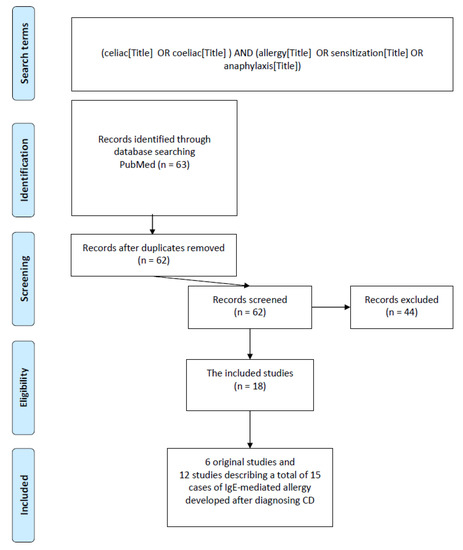Majsiak, E.; Choina, M.; Knyziak-Mędrzycka, I.; Bierła, J.B.; Janeczek, K.; Wykrota, J.; Cukrowska, B. Nutrients 2023, 15, 995. https://doi.org/10.3390/nu15040995
Abstract
In order to answer the question if an IgE-mediated allergy (A-IgE) may occur in subjects with celiac disease (CD), a systematic review was performed of available publications collected in the United States National Institute for Biotechnology Information/National Institutes of Health/National Library of Medicine/PubMed database up to 28 December 2022, with the use of the following keywords “allergy&celiac/coeliac”, “sensitization&celiac/coeliac”, and “anaphylaxis&celiac/coeliac” compared in the form of a conjunction. In total, the search returned 2013 publications from these keywords in any section of the article.
As numerous review articles included the above-mentioned entries in the abstract, we decided to focus on the publications with the entries only in the title (n = 63). After rejecting studies unrelated to the topic, narrative reviews, book chapters, conference abstracts, symposium reports, letters to the editor, or non-English articles, 18 publications (6 observational original studies and 12 case reports describing a total of 15 cases of A-IgE developed after a diagnosis of CD) were included to this review. Our study is the first systematic review on allergy occurrence in CD patients. The analysis indicated that the possibility of a coexistence of A-IgE with any food and inhalant allergens in subjects diagnosed with CD should be considered. A sensitization to wheat was the most frequently described in subjects with CD. The clinical manifestation of A-IgE in CD was similar to that in subjects without CD; e.g., with possible atopic dermatitis, vomiting, urticaria, angioedema, or anaphylactic shock. Screening for allergies in subjects with CD should be considered, especially in those cases where symptoms persist after introducing a gluten-free diet. The elimination of wheat from the diet of patients with CD may lead to a loss of immune tolerance and to the development of sensitization, which may even manifest as anaphylaxis. In conclusion, although there are few studies assessing the occurrence of A-IgE in subjects with CD, they show the possibility of a coexistence of both diseases and the high clinical significance of this phenomenon, which indicates the need for further studies.
No comments:
Post a Comment